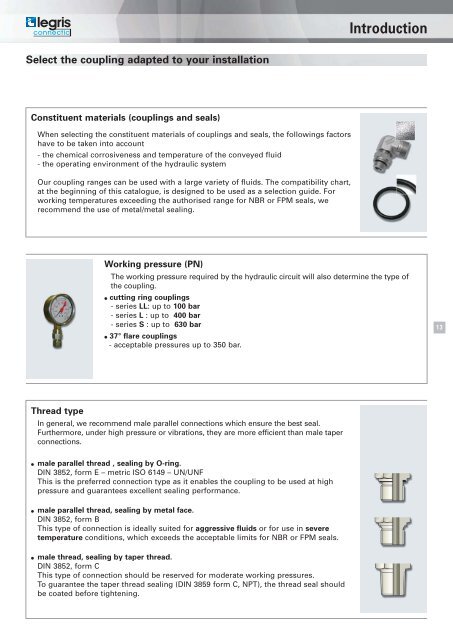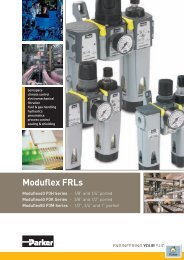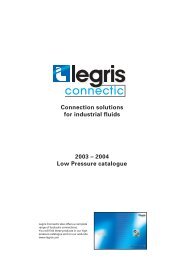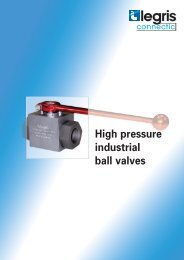- Page 1: Hydraulic catalogue
- Page 4 and 5: EditorialThis latest version of the
- Page 6 and 7: IntroductionLegris, a division of G
- Page 8 and 9: IntroductionA comprehensive range o
- Page 10 and 11: IntroductionA wide range of applica
- Page 12 and 13: IntroductionChromium VI free hydrau
- Page 16 and 17: IntroductionLegris correspondance t
- Page 19 and 20: Cutting ring couplingsto ISO 8434-1
- Page 21 and 22: Couplings to ISO 8434-1/DIN 2353Pri
- Page 23 and 24: Couplings to ISO 8434-1/DIN 2353Cut
- Page 25 and 26: Couplings to ISO 8434-1/DIN 2353the
- Page 27 and 28: Find easily the DIN product that yo
- Page 29 and 30: Couplings to ISO 8434-1/DIN 2353Nut
- Page 31 and 32: Couplings to ISO 8434-1/DIN 2353Mal
- Page 33 and 34: Couplings to ISO 8434-1/DIN 2353Mal
- Page 35 and 36: Couplings to ISO 8434-1/DIN 2353Mal
- Page 37 and 38: Couplings to ISO 8434-1/DIN 2353Mal
- Page 39 and 40: Couplings to ISO 8434-1/DIN 2353Str
- Page 41 and 42: Couplings to ISO 8434-1/DIN 2353Equ
- Page 43 and 44: Couplings to ISO 8434-1/DIN 2353Red
- Page 45 and 46: Couplings to ISO 8434-1/DIN 2353Bul
- Page 47 and 48: Couplings to ISO 8434-1/DIN 2353Adj
- Page 49 and 50: Couplings to ISO 8434-1/DIN 2353Adj
- Page 51 and 52: Couplings to ISO 8434-1/DIN 2353Adj
- Page 53 and 54: Couplings to ISO 8434-1/DIN 2353Sta
- Page 55 and 56: Couplings to ISO 8434-1/DIN 2353Adj
- Page 57 and 58: Couplings to ISO 8434-1/DIN 2353Adj
- Page 59 and 60: Couplings to ISO 8434-1/DIN 2353Adj
- Page 61 and 62: Couplings to ISO 8434-1/DIN 2353Adj
- Page 63 and 64: Couplings to ISO 8434-1/DIN 2353Adj
- Page 65 and 66:
Couplings to ISO 8434-1/DIN 2353Sta
- Page 67 and 68:
Couplings to ISO 8434-1/DIN 2353Adj
- Page 69 and 70:
Couplings to ISO 8434-1/DIN 2353Ban
- Page 71 and 72:
Couplings to ISO 8434-1/DIN 2353Hig
- Page 73 and 74:
Couplings to ISO 8434-1/DIN 2353Cho
- Page 75 and 76:
Couplings to ISO 8434-1/DIN 2353Hig
- Page 77 and 78:
Couplings to ISO 8434-1/DIN 2353Cho
- Page 79 and 80:
Couplings to ISO 8434-1/DIN 2353Mal
- Page 81 and 82:
Couplings to ISO 8434-1/DIN 2353Mal
- Page 83 and 84:
Couplings to ISO 8434-1/DIN 2353Mal
- Page 85 and 86:
Couplings to ISO 8434-1/DIN 2353Mal
- Page 87 and 88:
Couplings to ISO 8434-1/DIN 2353Str
- Page 89 and 90:
Couplings to ISO 8434-1/DIN 2353Str
- Page 91 and 92:
Couplings to ISO 8434-1/DIN 2353But
- Page 93 and 94:
Couplings to ISO 8434-1/DIN 2353Bul
- Page 95 and 96:
Couplings to ISO 8434-1/DIN 2353Mal
- Page 97 and 98:
Couplings to ISO 8434-1/DIN 2353Sta
- Page 99 and 100:
Couplings to ISO 8434-1/DIN 2353Red
- Page 101 and 102:
Couplings to ISO 8434-1/DIN 2353Mal
- Page 103 and 104:
Couplings to ISO 8434-1/DIN 2353Mal
- Page 105 and 106:
Couplings to ISO 8434-1/DIN 2353Mal
- Page 107 and 108:
Couplings to ISO 8434-1/DIN 2353Sta
- Page 109 and 110:
Couplings to ISO 8434-1/DIN 2353Ada
- Page 111 and 112:
Couplings to ISO 8434-1/DIN 2353BSP
- Page 113 and 114:
Couplings to ISO 8434-1/DIN 2353Mal
- Page 115 and 116:
Couplings to ISO 8434-1/DIN 2353Mal
- Page 117 and 118:
Couplings to ISO 8434-1/DIN 2353Fem
- Page 119 and 120:
Couplings to ISO 8434-1/DIN 2353Sta
- Page 121 and 122:
Couplings to ISO 8434-1/DIN 23533In
- Page 123 and 124:
Couplings to ISO 8434-1/DIN 2353Plu
- Page 125 and 126:
Couplings to ISO 8434-1/DIN 2353Loc
- Page 127 and 128:
Couplings to ISO 8434-1/DIN 2353O-r
- Page 129 and 130:
Couplings to ISO 8434-1/DIN 2353Cap
- Page 131:
Couplings to ISO 8434-1/DIN 2353Com
- Page 134 and 135:
Non-return valves to ISO 8434-1/DIN
- Page 136 and 137:
Non-return valves to ISO 8434-1/DIN
- Page 138 and 139:
Non-return valves to ISO 8434-1/DIN
- Page 140 and 141:
Non-return valves to ISO 8434-1/DIN
- Page 143 and 144:
37° flare couplings to ISO 8434-2
- Page 145 and 146:
37° flare couplings to ISO 8434-2A
- Page 147 and 148:
37° flare couplings to ISO 8434-2P
- Page 149 and 150:
37° flare couplings to ISO 8434-2M
- Page 151 and 152:
37° flare couplings to ISO 8434-2M
- Page 153 and 154:
37° flare couplings to ISO 8434-2M
- Page 155 and 156:
37° flare couplings to ISO 8434-2E
- Page 157 and 158:
37° flare couplings to ISO 8434-2B
- Page 159 and 160:
37° flare couplings to ISO 8434-2S
- Page 161 and 162:
37° flare couplings to ISO 8434-2A
- Page 163 and 164:
37° flare couplings to ISO 8434-2A
- Page 165 and 166:
37° flare couplings to ISO 8434-2A
- Page 167 and 168:
37° flare couplings to ISO 8434-2M
- Page 169 and 170:
37° flare couplings to ISO 8434-2A
- Page 171 and 172:
37° flare couplings to ISO 8434-2A
- Page 173 and 174:
37° flare couplings to ISO 8434-2P
- Page 175:
37° flare couplings to ISO 8434-2S
- Page 178 and 179:
High pressure industrial ball valve
- Page 180 and 181:
High pressure industrial ball valve
- Page 182 and 183:
High pressure industrial ball valve
- Page 184 and 185:
High pressure industrial ball valve
- Page 186 and 187:
High pressure industrial ball valve
- Page 188 and 189:
High pressure industrial ball valve
- Page 191 and 192:
Tube preparationand installation to
- Page 193 and 194:
Tube preparation tools and installa
- Page 195 and 196:
Tube preparation toolsCombined tube
- Page 197 and 198:
Installation toolsPre-installation
- Page 199 and 200:
Installation toolsMachine for 37°
- Page 201:
Installation tools199
- Page 204 and 205:
Technical recommendationsConformity
- Page 206 and 207:
Technical recommendationsConformity
- Page 208 and 209:
Technical recommendationsCompatabil
- Page 210 and 211:
Technical recommendationsSafety coe
- Page 212 and 213:
Technical recommendationsThreaded f
- Page 214 and 215:
Technical recommendationsTightening
- Page 216 and 217:
Technical recommendationsTightening
- Page 218 and 219:
Installation rulesTube preparation1
- Page 220 and 221:
Installation rulesInstallation of c
- Page 222 and 223:
Installation rulesInstallation of c
- Page 224 and 225:
Installation rulesInstallation of a
- Page 226 and 227:
Legris worldwideHEAD QUARTERSLegris
- Page 228 and 229:
index4730 182 1838040 104 1058118 6
- Page 230:
www.legris.com









